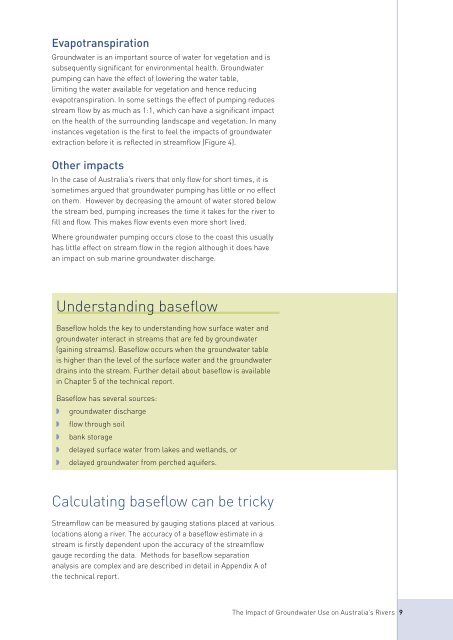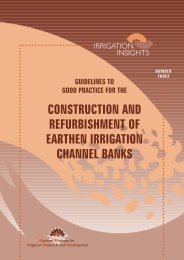The Impact of Groundwater Use of Australias Rivers
The Impact of Groundwater Use of Australias Rivers
The Impact of Groundwater Use of Australias Rivers
Create successful ePaper yourself
Turn your PDF publications into a flip-book with our unique Google optimized e-Paper software.
Evapotranspiration<br />
<strong>Groundwater</strong> is an important source <strong>of</strong> water for vegetation and is<br />
subsequently significant for environmental health. <strong>Groundwater</strong><br />
pumping can have the effect <strong>of</strong> lowering the water table,<br />
limiting the water available for vegetation and hence reducing<br />
evapotranspiration. In some settings the effect <strong>of</strong> pumping reduces<br />
stream flow by as much as 1:1, which can have a significant impact<br />
on the health <strong>of</strong> the surrounding landscape and vegetation. In many<br />
instances vegetation is the first to feel the impacts <strong>of</strong> groundwater<br />
extraction before it is reflected in streamflow (Figure 4).<br />
Other impacts<br />
In the case <strong>of</strong> Australia’s rivers that only flow for short times, it is<br />
sometimes argued that groundwater pumping has little or no effect<br />
on them. However by decreasing the amount <strong>of</strong> water stored below<br />
the stream bed, pumping increases the time it takes for the river to<br />
fill and flow. This makes flow events even more short lived.<br />
Where groundwater pumping occurs close to the coast this usually<br />
has little effect on stream flow in the region although it does have<br />
an impact on sub marine groundwater discharge.<br />
Understanding baseflow<br />
Baseflow holds the key to understanding how surface water and<br />
groundwater interact in streams that are fed by groundwater<br />
(gaining streams). Baseflow occurs when the groundwater table<br />
is higher than the level <strong>of</strong> the surface water and the groundwater<br />
drains into the stream. Further detail about baseflow is available<br />
in Chapter 5 <strong>of</strong> the technical report.<br />
Baseflow has several sources:<br />
◗<br />
◗<br />
◗<br />
◗<br />
◗<br />
groundwater discharge<br />
flow through soil<br />
bank storage<br />
delayed surface water from lakes and wetlands, or<br />
delayed groundwater from perched aquifers.<br />
Calculating baseflow can be tricky<br />
Streamflow can be measured by gauging stations placed at various<br />
locations along a river. <strong>The</strong> accuracy <strong>of</strong> a baseflow estimate in a<br />
stream is firstly dependent upon the accuracy <strong>of</strong> the streamflow<br />
gauge recording the data. Methods for baseflow separation<br />
analysis are complex and are described in detail in Appendix A <strong>of</strong><br />
the technical report.<br />
<strong>The</strong> <strong>Impact</strong> <strong>of</strong> <strong>Groundwater</strong> <strong>Use</strong> on Australia’s <strong>Rivers</strong> 9

















